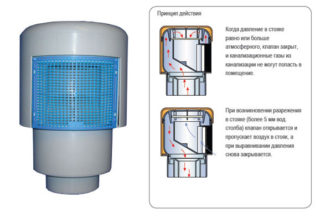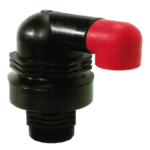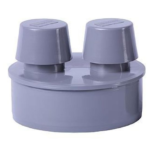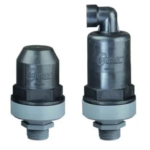The normal functioning of sewerage networks does not imply the presence of specific odors in the room. If this happens all the time, you need to install an aerator. In other words, the device is called a sewer ventilation valve. With its help, it is possible to compensate for pressure drops in the engineering network.
What is a sewer air valve and its scope
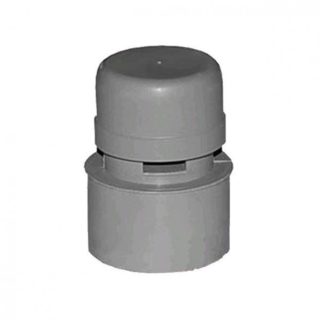
The aerator (air / fan valve) is a small circular device. Mounted on a sewer pipe in a vertical position. It is important not to confuse the device with a non-return valve, which prevents the return of water flow in the system.
Most often, the air valve is used:
- In unventilated sewer lines.
- On long horizontal sections of the collector (public toilets with a high risk of volley discharge).
- In cases where the plumbing is too far from the common riser and provided that the slope of the line is higher than the level of the water seal.
- In multi-storey engineering networks to optimize the work of the collector.
Additionally, small aerators are installed separately on sinks or showers / baths. This method is used in the event that there is a risk of pulling the liquid out of the water seal with excessive water consumption.
Device and principle of operation
- The body is polypropylene or polyvinyl chloride. Has a side opening / cut.
- Stem (or rubber diaphragm). It is the main part of the device. Facilitates the opening / closing of the side opening of the aerator.
- A dense rubberized gasket that ensures the tightness of the aeration device in the closed position.
- Top cover.
The aerator works according to the following principle:
- With a salvo discharge of wastewater into the sewage system, the rarefied pressure in the network increases sharply. As a rule, this happens when draining the toilet bowl waste water, etc. In this case, the liquid carries a lot of air with it. As a result, moisture from the water seals and elbows of the plumbing is also sucked into the main line, opening access to unpleasant odors from the collector to the apartment / house.
- When the pressure rises, the fan valve opens its side opening, equalizing the atmospheric values in the system. Thanks to this principle of operation of the sewer aerator, all liquid in the water traps / plumbing elbows remains in place. Ambre does not penetrate the room.
Ignoring the stench in the apartment in the absence of an aerator is dangerous to health. Sewer odors are a mixture of methane, hydrogen sulfide and ammonia. Together, they seriously undermine the functioning of the human body.
Types of air valves and their sizes
There are such types of fan valves on the market:
- Simple airy (kinetic). Works to release air from the system. Can be mounted indoors.
- Auto. Removes air masses under very high pressure from the line.
- Combined. It can simultaneously supply and remove air masses to / from the line. It is forbidden to install such aerators inside the house. Combined type devices are installed only outside the building in a specially equipped block.
Fan valves are produced in a standard section of 50 or 110 mm. The first ones are designed to be installed on a sink or shower stall. The second ones are for installation on a common riser pipe. However, you can find aerators with a cross section of 75 or 100 mm.
According to the method of installing the air valve, a distinction is made between external and internal. The first is inserted into the socket and fixed with corrugated rubber. The second one simply slips over the tee connector.
If the pipes in the house have a non-standard diameter, the installation of the air valve can be carried out using adapters.
Recommendations for choosing an aerator
When buying a vacuum valve for sewage, you should be guided by the following criteria:
- standard size - the diameter of the device, which must match the section of the pipe;
- installation method - open or closed;
- the presence of a diaphragm or stem in the locking mechanism;
- connection method - horizontal / vertical;
- the presence of a heat-insulating wall of the riser;
- device-specific ultimate pressure ratings;
- the material from which the aerator is made - it must be of the same type as the pipeline.
According to GOST, the vacuum valve is capable of withstanding up to 800,000 operating cycles.
Installation steps
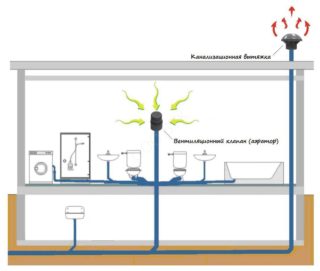
Air drain valves made of polypropylene or PVC are easy to install. The device is installed in a specially prepared socket. The aerator has a rubber seal for this at the lower end. You just need to put the fan valve on the existing horizontal / vertical opening.
If it is not initially available, you need to install an adapter under the aerator. They act here according to the scheme as follows:
- Cut off water to a house or apartment.
- On a section of the sewer / water pipeline, remove a piece and mount an adapter for the fan valve.
- Install the aerator into the bell. It is pre-cleaned of dust, treated with alcohol, and then coated with silicone sealant.
There are also a number of strict rules for installing an air sewer valve:
- The installation of the device is carried out in a room or in a specially equipped roofing block under the roof, the temperature in which never drops below 0 degrees. Frost interferes with the functional capacity of the aerator.
- Installation of the air valve on a network without a drain is carried out at a height of 10 cm from the uppermost outlet. If there is a ladder, the aerator is placed 35 cm from the floor level.
- With a hidden device of the sewer in the box at the level of the fan device, an inspection hatch is made.
- It is advisable to leave free access to the installed equipment in case of its inspection or repair work.
The aerator is more often installed in country cottages and private houses. If the master wants to mount the device in the apartment, a special permit must be obtained for this.
Features of operation
The installed device requires constant monitoring. During operation, it is necessary to monitor the operation of the stem. He or the membrane are prone to sticking in any of the positions.
If the aerator gets stuck in the “closed” position, it threatens to break the water seal. If the device sticks in the "open" position, sewage gases will flow into the room. In either case, the ends of the stem or diaphragm must be machined to eliminate the cause of the locking and to allow the aerator to open / close the stem freely.
Correctly installed in the apartment or on the roof, the aerator fully replaces the fan pipe.
Fixture cost
On the market, the price of fan valves varies depending on the diameter, brand and type of device. An aerator with a cross section of 50 mm will cost from 38 to 175 rubles / piece. Air valve 110 mm will cost from 90 to 1150 rubles / piece.
There are devices from three popular manufacturers on the market - Germany (Ostendorf), Scotland (McAlpine) and Russia (Politek).All three types of aerators are highly reliable, but have different prices for the same section.
Advantages and disadvantages
A properly installed device on a sewer pipe gives the homeowner a number of advantages:
- Normalization of pressure in the manifold line, exclusion of the breakdown of the hydraulic seal.
- The absence of stench from the sewer in the house.
- Saving money for the master. The aerator fully replaces the fan pipe, the installation of which would take more money.
- Simple and straightforward installation of the device, which even a novice master can handle.
- Increased sewage efficiency, especially if the house has 3 or more plumbing points.
With a mounted aerator, heat loss is significantly less than with a full-fledged ventilation pipe. In addition, the master has great freedom in designing a collector without being tied to a common riser if he installs a fan valve.

